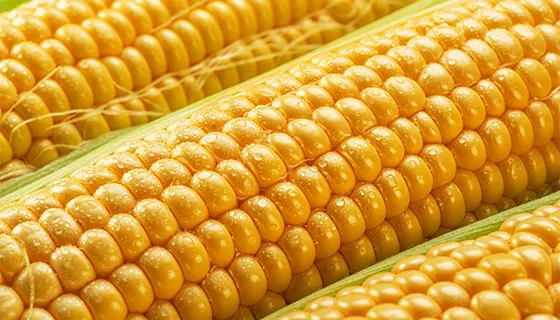
Is corn good for you? It can be. Sofia Wicker Velez, R.D., L.D.N., is a dietitian at Johns Hopkins Children’s Center. She provides insight on corn’s nutritional value and its place in American diets, along with a tempting recipe.
Nutritional Value of Corn
Corn served on its own has several health benefits, and, likewise, corn-based foods can be part of a nutritious diet.
For instance, Wicker Velez says, “Corn tortillas are a staple of Mexican food, and when combined with vegetables and protein, they can create a balanced meal. Kids love corn-based cereals, and the kinds with less added sugar can provide an easy-to-prepare breakfast or snack with the addition of milk, yogurt or fruit.”
For processed foods made with corn, it makes sense to check labels, since added ingredients will affect the nutrition profile. “Be aware of foods with too much added sugar, sodium or saturated or trans fats,” she advises.
Low Calorie, Low Fat
A medium ear of sweet corn or a half cup of fresh, frozen or canned kernels (without added sugar or salt):
- Has about 77 to 100 calories
- Is naturally gluten-free and low in fat, with only about one gram of fat per ear (not including butter and other oily add-ons). The majority of that gram of fat is polyunsaturated, the kind of fat that can help reduce cholesterol and inflammation
Vitamins, Minerals, Antioxidants
That same medium ear of sweet corn or a half cup of fresh, frozen or canned kernels (without added sugar or salt) has:
- About 3 grams of protein
- 5 milligrams of sodium
- 244 international units of vitamin A
- About 15 milligrams of carbohydrates, including about 5 milligrams of sugar
- Small amounts of B vitamins, magnesium and potassium
- Antioxidants that ease wear and tear on the body’s cells, including:
- Vitamin C
- Lutein and zeaxanthin, which support vision and eye health
High Fiber
Corn has plenty of fiber, both soluble and insoluble. The soluble fiber in corn breaks down and forms a gel in the intestines and can play a role in controlling cholesterol. Soluble corn fiber is used in the manufacture of processed foods.
The covering of each delicious kernel of corn is insoluble. This is the undigestible kind that the body cannot break down and that passes through the body more or less intact, which can add bulk to bowel movements and ease constipation. Corn’s insoluble fiber also acts as a prebiotic, feeding and supporting the growth of healthy gut bacteria.
Is corn a grain, a starch or a vegetable?
Corn can be eaten as a grain or a starchy vegetable. “When advising our patients with both type 1 and type 2 diabetes, we teach that corn should be considered a carbohydrate,” Wicker Velez says.
“In Latin culture, corn is regarded as a grain. It is harvested once it’s fully mature and dried and ground into flour to make tortillas,” she says. “In contrast, Americans of European ancestry are more likely to harvest corn when the kernel is soft and juicy and serve it as a vegetable, steamed, fried or roasted.”
Hominy is a food made from dried kernels of field corn soaked in an alkaline solution then thoroughly rinsed. Hominy can be ground into grits (a popular item in Southern U.S. cuisine) or masa for Latin American dishes.
Is popcorn healthy?
Popcorn, made from the dried kernels of a type of corn called flint corn, can be a healthy, filling, whole-grain snack if the benefits of the corn aren’t overshadowed by added fat and sodium. Unfortunately, that’s a big “if”: Many prepared popcorn products and popcorn sold at movie theaters and sports events are too high in salt and grease to be good for you. For example, a tub of movie theater popcorn can pack over 1,000 calories and 2,650 milligrams of sodium.
The healthiest choice is plain air- or microwave-popped popcorn you make yourself (not packaged microwave popcorn). Three cups of plain popcorn is only 95 calories and 3.6 grams of fiber.
Healthy Microwave Popcorn
- Put 1/4 cup of plain popcorn kernels in a paper bag and fold the end of the bag over.
- Microwave on high until you hear two seconds between popping kernels.
- Drizzle or mist a small amount of olive oil or other healthy oil on the popcorn and lightly toss with parmesan, pepper or your favorite herbs and spices.
Beyond the Cob: Other Uses for Corn
Corn is a major crop in the United States, and a large portion of the continental U.S. is well suited to growing it. Corn types eaten by human beings comprise only a small fraction of the corn grown and harvested. The rest is field corn, processed for animal feed and used in the manufacture of ethanol, a fuel additive.
In addition to edible kernels, corn provides:
- Corn flour that can be used to make cornbread, tortillas or polenta.
- Corn oil, which is a natural source of CoQ10, a vitamin associated with heart health.
“Corn is very versatile,” Wicker Velez says. “The entire plant has uses. For instance, corn husks can be used to make tamales or woven as a textile to make shoes or baskets. Cornsilk is dried and used in traditional Chinese and Native American medicine as a tea.”
Corn Syrup
Perhaps the most common form of corn in the U.S. diet is corn syrup, which goes into many processed foods to add texture and sweetness. Derived from the starch of field corn, corn syrup comes in several different varieties.
“Corn syrup in its basic form is pure glucose, a different molecule from sucrose, which is granulated table sugar,” says Wicker Velez. “High-fructose corn syrup, or HFCS, is another variety that is processed to change glucose into fructose, which is twice as sweet as sucrose.”
Wicker Velez notes there is little nutritional difference between table sugar, HFCS and other syrups — even trendy, expensive ones such as agave. But because HFCS is so inexpensive to make, it finds its way into a lot of processed snacks and beverages where it contributes to obesity and associated conditions such as metabolic syndrome.
“Candies and other processed baked goods, sweets and soft drinks made with HFCS are likely to have little or no protein or fiber, so they won’t make a person feel full,” she explains. “It may be easy to overeat the types of foods sweetened with HFCS and end up consuming too many calories.”
Recipe: Rainbow Corn Salad
This tangy, colorful combination makes a great side dish with fish or lean protein, and is perfect for taking to potluck gatherings.
INGREDIENTS
- Two medium limes
- 1/4 cup olive oil
- 1/2 teaspoon kosher salt
- 1/4 teaspoon freshly ground black pepper
- 2 cups of canned corn (drained)
- ½ cup of black beans (drained)
- 1/2 medium red onion
- 1 pint cherry or grape tomatoes
- 1/2 small bunch fresh herbs, such as cilantro, parsley, dill, basil or a combination
- Two medium ripe avocados
- cotija cheese
INSTRUCTIONS
- Juice two medium limes. Place 2 tablespoons of the juice, 1/4 cup olive oil, 1/2 teaspoon kosher salt, and 1/4 teaspoon black pepper in a large bowl, and whisk until combined.
- Add each to the bowl with the dressing as you complete it: 2 cups of canned corn, 1/2 cup of black beans. Dice 1/2 medium red onion (about 3/4 cup). Halve 1 pint cherry tomatoes. Coarsely chop 1/2 small bunch fresh herbs until you have 1/4 cup. Mix together with a flexible spatula until combined.
- Dice two medium ripe avocados and place in a medium bowl. Drizzle with the remaining lime juice and toss to coat. Just before serving, add the avocado to the salad and stir gently to combine.
- Sprinkle cotija cheese on top and enjoy!
A Shared Heritage
Corn is important to culture as well as diet. It was domesticated in the Americas thousands of years ago and was sacred to ancient people of Mexico. Some Native American nations’ lore tells of a nurturing spirit who gave corn to her people to sustain them, and some tribes still celebrate the ripening of the corn harvest with spiritual ceremonies, dances and feasts. Wicker Velez points out that corn was on the table at the first Thanksgiving in what would later become the United States.
Explorers first introduced corn to Europe in the late 15th century. Though it never replaced wheat bread, pasta and potatoes across the ocean, corn is still essential to the Americas. In one form or another, corn still appears regularly on tables from Canada to the southernmost points of Chile and Argentina.


